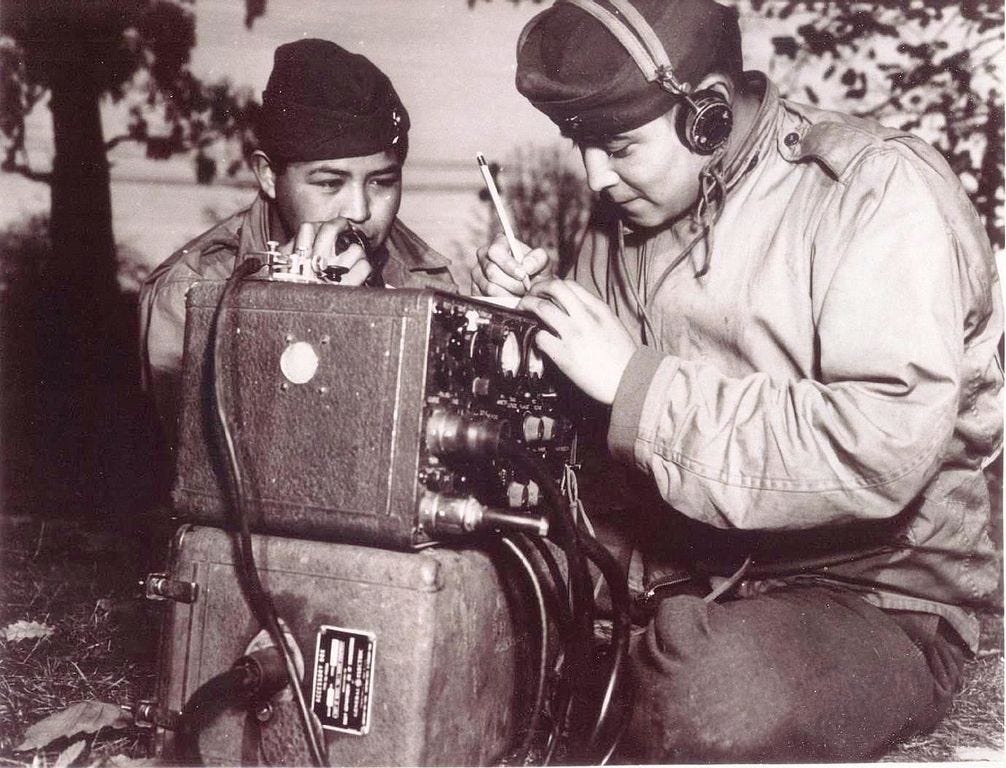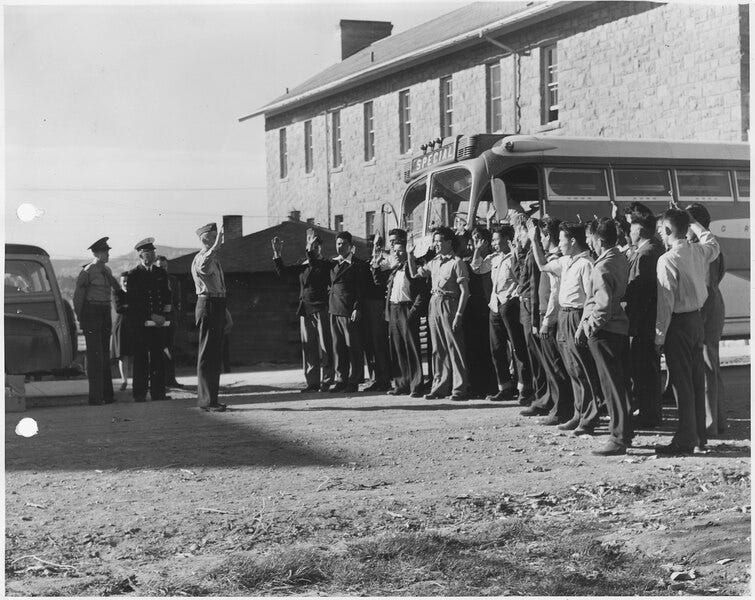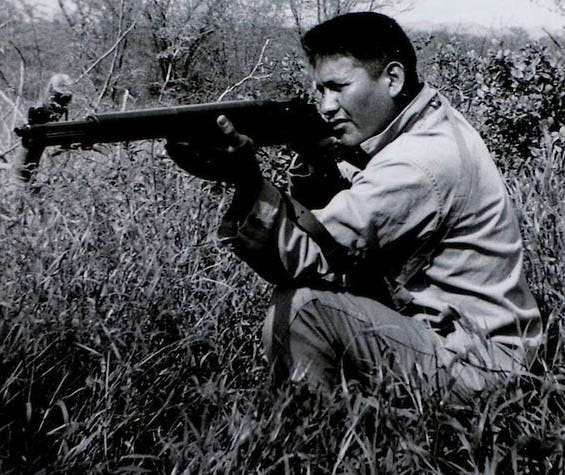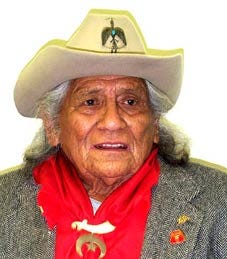Words With Power
The Code Talkers' Legacy of Language

The American Indian Code Talkers are often celebrated as unsung heroes whose intricate language was instrumental in turning the tide of World War II. Their story, classified for more than two decades after World War II, is far richer than a mere recounting of their battlefield exploits. To truly honor their complex legacy, we must delve into the depths of their personal journeys, military experiences, and the challenges they faced upon returning home.
Incredible Effectiveness
From Hungarian-speaking people serving with Ukraine in their present-day war with Russia, to the Choctaw code talkers in World War I, the use of Indigenous and little-known languages to quickly slip messages past opponents have been employed by militaries since radio communication was developed.
The United States made especially effective use of Native American languages, which were unique, unwritten, and virtually unknown anywhere else in the world. After code talkers were used effectively in WWI, both Germany and Japan sent students to the U.S. to study the languages before WWII. However, the effort was unsuccessful due to the myriad Native American dialects and difficulty in learning them. The Navajo Code developed for WWII still holds the distinction of being the only spoken military code that was never broken.

The Navajo Code Talkers were a unique force within the United States military. These young men (the first 29 ranged in age from 15 to 35, the eldest and youngest both lying about their age to enlist) underwent rigorous training that combined military drills with the development of a complex code based on their native tongue.
Early in WWII, Major General Clayton B. Vogel of the U.S. Marines met with a civil engineer named Philip Johnson and witnessed a demonstration of Navajo Code Talkers transmitting a three-line, coded message in 20 seconds; something that would have taken the machines of the time 30 minutes! Vogel recommended the Marines recruit 200 Navajo, but only a pilot project of 30 men was approved at first. One dropped out.
Eventually, the U.S. Marines alone would employ 461 Navajo Code Talkers in WWII.
More Than Just Warriors
Imagine leaving behind everything familiar to embark on a perilous journey into the unknown, the only certainty being violent confrontation with an aggressive nation, on behalf of another nation that hasn’t shown your people much respect. This was the reality for the brave men of the code talkers.
While their linguistic skills were invaluable, it's essential to remember that they were also husbands, sons, and brothers who experienced the same fears and anxieties as any other soldier. They endured the rigors of basic training, forged bonds with fellow soldiers, and undoubtedly faced instances of prejudice and discrimination. Yet, they persevered, their commitment to the safety of their home and their people driving them forward.
Ironically, many of these linguistic heroes hailed from boarding schools where speaking their native Navajo was strictly forbidden. These institutions, designed to assimilate Native Americans into mainstream culture, failed to destroy a language that would prove invaluable to the war effort.
Chester Nez was about 21 years old when the United States joined WWII. He kept his decision to enlist in the Marines from his family and was one of the first 29 Navajos who formed Recruit Training Platoon 382 in May of 1942. Together, they created the code that would be used across the Pacific Theater of war.
During the first two days of the Battle of Iwo Jima, six Navajo Code Talkers sent and received over 800 messages without a single error. The messages they delivered were credited with saving hundreds of lives.
“Were it not for the Navajos, the Marines would never have taken Iwo Jima.”
- Major Howard Connor, 5th Marine Division signal officer
The battlefront was a crucible that tested their courage and resilience. From the intense fighting on Iwo Jima to the grueling campaign on Okinawa, the Navajo Code Talkers were at the heart of the action. Their ability to transmit critical information swiftly and securely proved to be a game-changer.
While code talkers weren’t as widely deployed in the European Theater of WWII, a group of 17 Comanche men were recruited to make a code to outwit Nazi forces.
Charles Joyce Chibitty served as a Comanche Code Talker during the Battle of Normandy. He and 12 other code talkers landed at Utah Beach on D-Day and their efforts saved the lives of thousands.
“Five miles to the right of the designated area and five miles inland, the fighting is fierce, and we need help.”
- Chibitty’s first message to command on D-Day, translated to English
Chibitty and other Comanche Code Talkers were named Knights of the National Order of Merit by the French government in 1989.
Returning Home: The Unsung Chapter
Code talkers, despite their invaluable contributions to the war effort, faced a myriad of challenges upon returning to their civilian lives and communities.
Many returned to impoverished reservations with limited economic opportunities. The transition from the relative stability of the military to the harsh realities of reservation life was difficult. Discrimination persisted, limiting their access to education, employment, and even voting rights.
Like many veterans, the code talkers struggled with the psychological aftermath of war. Post-traumatic stress disorder (PTSD), depression, and anxiety were common. Reintegration into a community that had changed in their absence could be isolating. Many found it difficult to reconnect with their pre-war lives.
The secrecy surrounding their wartime role added another layer of isolation. The military asked them to stay silent about their role in service, in case they were needed again in the future. They refrained from sharing their experiences with loved ones, further compounding the emotional toll. Their heroic role in the war wasn’t declassified until 1968.
Despite the adversities they encountered, the legacy of the code talkers is one of courage, resilience, and unwavering patriotism. Their story is a testament to the human spirit and the enduring power of culture.
More about Code Talkers
Navajo Code Talkers of World War II (2018) (Full Movie on YouTube)
Navajo Code Talkers and the Unbreakable Code (2008) (includes a code-breaking exercise)
Code Talkers Were America’s Secret Weapon in World War II (2022)
In Search Of History - Navajo Code Talkers (History Channel Documentary on YouTube)


